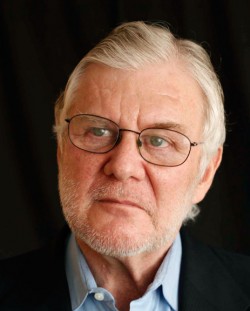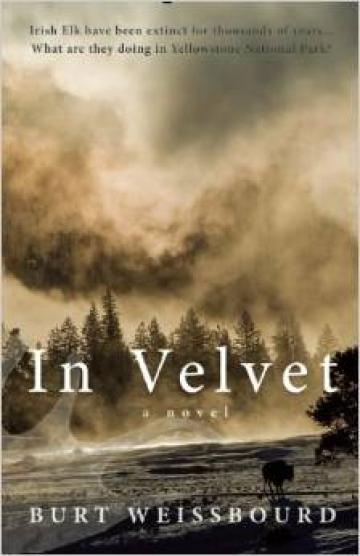KGB Interview: Burt Weissbourd
"The art of good business is being a good middleman."
So it is said (often) in the underrated movie Layer Cake, starring Daniel Craig, in a role, dare I say, that is much cooler than his more famous turns as James Bond. I think the line serves as a good start to my interview with novelist Burt Weissbourd, not because he was a former Hollywood producer and screenwriter, but because a middleman brought us together —Tyson Cornell, founder of Rare Bird Lit, a New York and L.A.-based firm that specializes in author book promotions, and an emerging publisher of top-rate fiction, including Burt's new novel In Velvet. So with a tip of the hat to Tyson, here's the interview:
Q: You started off your career in Hollywood as a screenwriter, and then started a film production company, before turning your attention to novels. With a long history of authors who made the opposite transition, what fueled your arc to leave Hollywood behind and write novels? Also, what did you learn from your screenwriting days that you think has helped your work with novels?
I actually started my career in Hollywood as a producer and became a screenwriter later. Here's why I left Hollywood:For many years I produced movies, and I found that the longer I did that, the more cynical and burnt out I became – movies got made for the wrong reasons: the best work on screenplays wasn't often recognized; as a producer, I didn't have creative control over the final product – an actor or a director could demand a rewrite of a very good script, fire a writer on a whim, etc. I started writing screenplays, and though I was able to make deals for them, I became even more frustrated over how difficult it was to get them made and how difficult it was to control the choice of director, actors, etc. More and more it was clear to me that film was a director's medium, and I had to decide whether I wanted to become a director or do something else. I had young children and I wanted to spend time with them (very hard to do as a working film director), so I decided to spend more time writing. Eventually, I began writing novels. Once I started, there was no turning back. I loved it.
As a producer my focus and the quality of my work diminished the longer that I did it. As a writer, the opposite has been true – as I write more, I believe the quality of my writing improves. Finally, as a producer, you spend your time managing other people's problems. As a writer, you are, at least, choosing the problems (often your own) that you want to deal with, and for me, that's been a wonderful change.
Most of what I know about writing comes from working with wonderful writers and screenwriters as a producer.Early in my producing career, I had the privilege of working with author Ross Macdonald, a legend in crime fiction, on his only screenplay. He helped shape my own storytelling craft. Working with him, I began to see how characters could drive plot.
I continued learning to write from some of the best screenwriters ever – writers whose works grabbed viewers viscerally, not with explosions but with multi-dimensional characters that would draw you into a deeply moving story. I spent countless hours working out stories and discussing the people in them with the following screenwriters, with some of their most famous works noted in parentheses: Frederick Raphael (Two for the Road), Alvin Sargent (Ordinary People, Julia), Andy Lewis (Klute), Joe Eszterhas (Basic Instinct), Ron Bass (Rain Man), Stewart Stern (Rebel Without a Cause). William Wittliff (Lonesome Dove,Raggedy Man), Larry D. Cohen (Carrie,Ghost Story), etc. (these writer's film credits are for identification purposes. Excepting Raggedy Man and Ghost Story, I did not work on these films.)
Working closely with these great screenwriters was a rare opportunity to learn about complex characters and story telling.As a producer developing a screenplay, you look for stories with strong, complex characters and a "rich stew" — that is to say, a situation with conflict, emotional intensity, and the potential to evolve in unexpected ways. This is exactly what I look for in books I love, and of course, try to infuse in the character-driven thrillers that I write.
Q: You have a psychology background, which is revealed in your characters, the inner narrative you provide them where they often question and explore their emotions. Is this a conscious choice to infuse them with this type of introspective, and how important do you think it is for mystery novels like yours to have this psychological component?
Yes, this inner narrative, this self awareness, is a conscious choice. I describe what I write as character-driven thrillers. And all of my characters have intense emotional lives that they experience, observe and reflect on. By making my central characters self aware, it allows a reader to understand the choices that move the story forward.I am fascinated by high stakes situations filled with eccentric characters. By giving these characters a rich, inner life, we are inside their heads a lot and can enjoy their quirks, their decision making, their perceptions and their humor.Finally, I'm interested in juxtaposing frightening external events and emotionally vulnerable people. In In Velvet, Rachel, the emotional bear biologist is dealing with wildlife abnormalities and mutations in the young. In Inside Passage, Abe and Corey are confronting a sociopath and a murderer who is running for State Attorney General. How they consciously sort through these harrowing external realities is part of the texture of the novel.
Q: Your writing reminds me a bit of the great Raymond Chandler mysteries, in that there is a tight, clear, hard-hitting prose, coupled with great vulnerability in the characters. Plus, your attention to detail when it comes to settings is precise like Chandler, and helps set a tone. That said, are you a fan of other mystery writers. If so, who, and have they and their books influenced your writing.
The Instant Enemy by Ross MacdonaldWhen I first decided to become a film producer in 1974, I called Ken Millar (Ross Macdonald) and asked him if he'd write a screenplay for me based on one of his books. He'd never worked on a film before. We chose The Instant Enemy, and Ken wrote a long treatment. We hired another screenwriter to write a screenplay, then Ken came back to the project and wrote a screenplay of his own. I worked closely with this “grand master” between 1975 – 1979.
We met often and discussed all aspects of the project as well as other films of the time such as Chinatown. It was an extraordinary experience for me, and a lot of what I know about character-driven thrillers and writing psychologically complex characters I learned from Ken.
The Girl with the Dragon Tattoo by Stieg Larsson
In my view, this is an original and a superb character-driven thriller. It greatly influenced me when I was writing Inside Passage and more recently, In Velvet. He succeeds in creating a very strong, unique and memorable female protagonist, Lisbeth. I try to write strong women in my books and this book taught me how to do that in less conventional ways.I also love, Raymond Chandler, Dashiell Hammet, Scott Turrow, and Ross Thomas.
Q: What's next?
My next book is Teaser, the sequel to Inside Passage and the second book in the Corey Logan Trilogy. Here's how I describe it on my website:
Teaser, the sequel to Inside Passage, takes Corey and Abe into the interconnected worlds of private school kids and the runaways who roam Seattle's streets. Billy attends the Olympic Academy, where two friends, Maisie and Aaron, are experimenting with sex and drugs. They've become close to Star, a streetwise seductress who leads them down a treacherous path. Despite the best efforts of Abe and Corey, Maisie is abducted by the diabolical Teaser, a man determined to take revenge on her father, his former cellmate. Teaser is a mystery to everyone except Abe and Corey, who alone realize what they must do to rescue Maisie. They contrive a plan that shocks even them.

Burt Weissbourd's new novel, In Velvet, is available by pre-order on Amazon (http://tinyurl.com/lrgyykc). To find more of his work, go to www.burtweissbourd.com.
